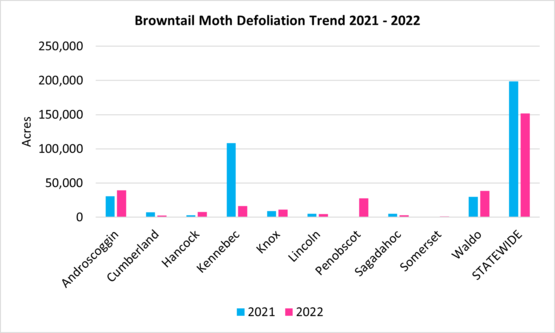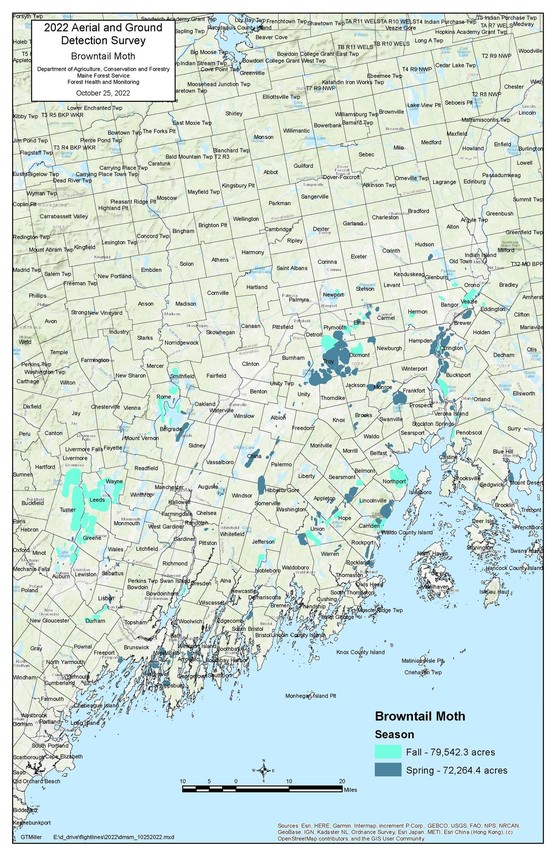|
It is no surprise that this has been yet another busy year for browntail moth (BTM), with ups and downs along the way. In two rounds of aerial damage surveys, we mapped a total of 151,806 acres of damage: 72,264 acres of defoliation were mapped in the early summer, and 79,452 acres of damage in the early fall. In comparison, last year, there were 198,773 total acres of damage mapped.
 Defoliation trends by county from 2021 to 2022. Androscoggin: increase to 39,344 acres. Cumberland: decrease to 2,315 acres. Hancock: increase to 7,520 acres. Kennebec: decrease to 16,307 acres. Knox: increase to 11,320 acres. Lincoln: decrease to 4,676 acres. Penobscot: increase to 27,719 acres. Sagadahoc: decrease to 2,861 acres. Somerset: increase to 1,382 acres. Waldo: increase to 38,352 acres. Statewide total: decrease to 151,806 acres.
 Areas mapped during aerial survey for browntail moth. Populations of the caterpillars were moderate to severe in the areas mapped at the time of survey.
Looking back at the entire season, we received our first confirmed report of BTM caterpillars emerging from their winter webs beginning the week of April 11; this was followed by more widespread reports on the week of April 18. As in previous years, we continued monitoring our network of monitoring sites throughout the season. The weekly observations from these sites were posted in developmental updates for the public and stakeholders on the Maine Forest Service BTM website. We also created a Browntail News Bulletin this year.
During preliminary checks at several monitoring sites, we observed many webs with dead caterpillars on the outside from late last summer; this appears to be a little more widespread than previously thought, at least throughout Kennebec County. Starting the week of May 16, we began seeing fourth instar caterpillars at all our developmental monitoring sites. The fourth instar and older caterpillars have white markings on the sides of each body segment and have more of the irritating hairs that affect humans. At this stage of caterpillar development, their activity and appetites increase rapidly, increasing the number of irritating hairs and diminishing leaf area. During this time, we also started observing large amounts of defoliation as far north as Bangor. As in previous years, a high rate of variability in caterpillar development within sites was observed. For example, at one of our monitoring sites, there were 23-mm-long caterpillars alongside 9-mm caterpillars, indicating little development since emergence.
Many areas of Maine experienced windy weather the third week of May, which hastened the process of some of the caterpillars leaving their host trees, as many were blown to the ground. This, in turn, brought more caterpillars into contact with people.
We inoculated three sites (Deer Isle, Cumberland, and Chelsea) in mid-May with fungus-killed BTM caterpillars collected the previous summer to test if this would be a viable method for assisted disease dispersal to manage populations. All three sites later showed signs of fungus-related caterpillar mortality. This was confirmed at two of those sites within a week of inoculation and from the third site in Deer Isle by the week of June 20. These findings are promising; however, it was observed that the pathogen activity was locally confined to the inoculated trees and adjacent ones. In late May, we noticed that a fungal pathogen had killed caterpillars at some of our monitoring sites. This was aided by a few rainy days in May.
During the last week of June and early July, we received our first reports of adult BTM. In the Capitol Region and likely other areas of Maine, noticeably fewer moths were seen at many lights in town compared to last year. We also created a simple chart to differentiate other white moths that are often confused with BTM.
Feeding of newly hatched caterpillars was visible by mid-August in many areas. Now, the caterpillars are wrapped up tightly in their winter webs, where they will remain until early spring. Webs are visible now in trees that have dropped their leaves. It is not too early to get an idea of population levels where you are. Webs are most visible on sunny days. Look for them on hardwood tree branches, at the tips of the branches. A key identification clue is a bright white silken rope laid down by caterpillars throughout the late-summer and early fall. The webs are generally palm sized and often smaller. Each web is the overwintering home to anywhere from a couple of dozen to several hundred tiny caterpillars.
The Maine Forest Service is accepting comments on the proposed rule to establish standards for the administration of the Browntail Moth Mitigation Fund. Comments will be accepted through December 2, 2022 at 4:30 PM. Written comments may be emailed to allison.m.kanoti@maine.gov or sent to:
Allison Kanoti
Maine Forest Service
87 Airport Road
Old Town, ME 04468
Opportunity to provide public comment is also available at a public hearing to be held November 22, 2022, 9:30 AM, at the Maine Forest Service Central Region Headquarters, 87 Airport Road, Old Town, ME.
The Fund was created to provide funding to government entities or nonprofit organizations to support the mitigation of browntail moth in areas of Maine with significant populations. The draft rule includes details on the types of organizations that can apply for funds, the application process, the types of activities that could be funded, and how funds will be disbursed.
|